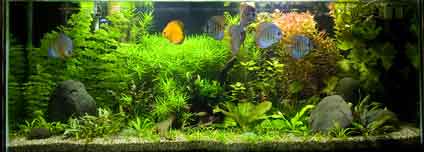
This are aquariums in which you will find fish and aquatic plants from different family or genus. Choosing fish or plants for this type of aquarium aquarists usually focus on their external appearance - mostly colours, shape, way of moving, level of water fish prefers to swim (bottom, top or middle part of the aquarium), etc. But there is one thing we have to be aware of - fish and plants for this aquarium need to have similar requirements in relation to light, temperature, size of the aquarium and correct nutrients in water. You also should not keep predatory fish in the general aquarium as they will hunt for smaller species. Weaker and smaller fish will be hiding from them and get stressed or may be even eaten. In general aquarium you also should not keep fish who dig in the substrate or eat plants. Most of the fish feels the best among their own species. That is why you should have small groups of each species instead of twenty fish and each from different group.
This are special function aquariums in which fish will have perfect conditions to spawn. Spawning tank should not be high (around 25 cm = 10"), shoild be quite wide (40cm = 16") and long (40cm to 80cm which is 16" to 32"). This dimensions should be good for most aquarium fish and will guarantee easy maintaining. Aquarium should be made completely of glass (frame aquarium is not suitable). Temperature should be kept stable. You also need a filter and water pump to increase water circulation which will increase amount of oxygen in water. Light should not be to strong and it should be on for the same amount of time every day. Rapid changes in lighting are dangerous for fry. For most fish you do need a substrate but some fish may also need gravel, boiled peat, roots, rocks, coconut shell or pot. If you want plants in spawning aquarium you can use bunch of Myriophyllum or Java Moss. Spawning tank can have a substrate made of two layers of marbles or a nylon netting just above the bottom glass or above the gravel. As the eggs are laid, they fall through these layers and parents will not be able to eat it. If you breeding fish which care for their eggs and fry you should not use marbles or a nylon netting.
These are aquariums in which we try to reproduce natural environment and keep biological balance similar to natural biotopes. You can for example reproduce habitat for fish living in lakes, rivers or streams.
In these aquariums you provide optimal conditions which are similar to nature for just one species. You can observe behavior in the environment which may be different just a little bit from the natural environment.
You need to remember that if you want to keep fish from one continent they should live in similar conditions. One continent may have different environment in different parts. It is not wise to keep fish from different environments in one aquarium. For example do not keep together fish living in rush streams of Andes with waters of the Brazilian savannas.
If you are trying to establish a domestic aquarium from your region then it will be easy to get fish and plants but the problem is to acclimatise them. To do it right you will need minimum 50-100 litres aquarium (for bigger fish 200 litres), water need to be filtered all the time. Water should also be oxygenated. We need to change 20-30% of the water quite often - every 1-2 weeks. There is quite big problem with fish from mountain streams. You need to provide water motion for them and keep water quite cold. In some climates you need to decrease temperature to 4-8°C for winter time. This is quite difficult to do especially if you love in work climate. You have to be careful because doing it wrong may damage plants or kill fish.